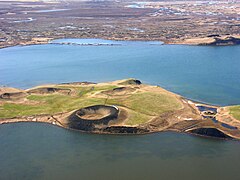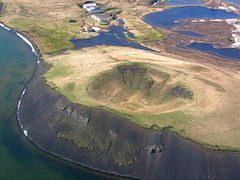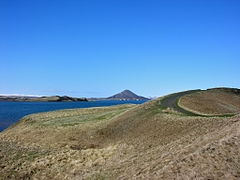Rootless cones of Skútustaðir
Jump to navigation
Jump to search
Deutsch: Die Pseudokrater von Skútustaðir gehören zum kleinen Heiðarsporðar-Vulkansystem im Norden Islands beim See Mývatn. Sie entstanden in phreatomagmatischen Explosionen als vor ca. 2300 Jahren Lava über Feuchtgebiete bzw. Teile des damaligen Sees strömte.
English: The crater group Rootless cones of Skútustaðir (also called pseudocraters) is to be found to the eastern side of and in the form of islands in the lake Mývatn in the north of Iceland. The craters are not connected to volcanic pipes or dikes, but originate from explosions when lava from the volcanic system of Heiðarsporðar rann over swamps around 2300 BP.
Français : Les Skútustaðagígar, toponyme islandais signifiant littéralement en français « cratères de Skútustaðir », sont un ensemble de pseudo-cratères d'Islande situés dans le Nord du pays, sur la rive méridionale du Mývatn. Ils sont nés lorsqu'une coulée de lave, émise par des fissures du système volcanique du Heiðarsporðar il y a 2300 ans à peu près, est entrée en contact avec les eaux du lac, créant des explosions qui ont édifié ces cratères volcaniques dépourvus de racine.
Íslenska: Skútustaðagígarnir eru gervigígar sem finnst hjá Skútustöðum við Mývatn. Þeir urðu til í sprengingum fyrir rúmlega 2 þúsund árum, þegar Laxárhraun yngra rann yfir mýrar og vatnið.
Maps[edit]
-
The lake Mývatn is located in the northeast of Iceland
-
Mývatn: The most famous ones of the rootless cones are in the south of the lake near Stakholstjörn
-
Maps of some of the rootles cones
Aerial photographs[edit]
Walking and hiking within the pseudocrater area at Skútustaðir[edit]
The cones seen from other viewpoints[edit]
-
From the river Laxá í Aðaldal with the volcanic mountains Vindbelgjarfjall, Hlíðarfjall, Krafla and Jörundur in the background
-
From the east side of the lake
-
Some rootless cones are islands
-
Vindbelgur in the background
Lava flows of the Younger Laxárhraun travelled in lava tubes to the swamps and the lake[edit]
-
Lava tubes can be many kilometers long
Hydromagmatic explosions: When the lava reached the swamps and the lake[edit]
-
The rootless cones in the lake could be a product of very similar explosions to these at Kilauea



























